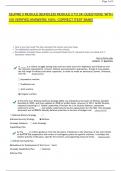Page 1 of 3
SEJPME II MODULE [BUNDLED] MODULE 2 TO 24| QUESTIONS WITH
100 VERIFIED ANSWERS| 100% CORRECT [TEST BANK]
• Here is your test result.The dots represent the choices you have made.
• The highlighted questions are the questions you have missed.
• Remediation Accessed shows whether you accessed those links.'N' represents links not visited and 'Y'
represents visited links.
Back to Status page
contains 11 Questions
1) is a violent struggle among state and non-state actors for legitimacy and influence over
the relevant population(s). It favors indirect and asymmetric approaches, though it may employ
the full range of military and other capacities, in order to erode an adversary's power, influence,
and will. [objective51]
Asymmetric warfare
Traditional war
Joint warfare
Irregular warfare
2) The first-ever National Defense Strategy (NDS) was initiated by Secretary of Defense (SecDef)
Rumsfeld in 2005, and then updated in 2008 by SecDef Gates. However in 2012, SecDef Panetta
released Sustaining U.S. Global Leadership: Priorities for 21st Century Defense, sometimes
referred to as the , and widely understood to be the replacement for the NDS. This strategic
document was written to identify defense priorities in the face of budget cuts. [objective52]
National Military Strategy
National Security Strategy Defense
Strategic Guidance Joint Strategic
Capabilities Plan
3) The is written guidance from the Secretary of Defense to the Chairman of the Joint Chiefs
of Staff for the preparation and review of contingency plans for specific missions. It includes the
relative priority of the plans, specific force levels, and supporting resource levels. [objective53]
Unified Command Plan
Guidance for Employment of the Force Joint
Strategic Capabilities Plan National
Defense Plan
, Page 2 of 3
4) The is the President's principal forum for considering national security policy matters
with his senior national security advisors and cabinet officials. [objective54]
Secretary of Homeland Security
, Page 3 of 3
Secretary of Defense
National Security Council Joint
Chiefs of Staff
5) The operational chain of command runs directly from the President to the Secretary of Defense
and then to the . [objective55]
Chairman of the Joint Chiefs of Staff
Chairman of the Joint Chiefs of Staff and then to the Combatant Commanders
Combatant Commanders
Service Chiefs
6) The four categories of support are . [objective61]
general, tactical, operational, and strategic
tactical, operational, direct, and common
general,mutual, direct, and close reinforcing,
mutual, complementary, and close
7) The U.S. Transportation Command, U.S. Special Operations Command, and U.S. Strategic
Command comprise the . [objective57]
geographic combatant commands
functional combatant commands Service
component commands functional
component commands
8) The is a joint force that is constituted and so designated by the Secretary of Defense, a
combatant commander, a subordinate unified commander, or an existing Joint Task Force
commander to accomplish missions with specific, limited objectives and which do not require
overall centralized control of logistics. It is dissolved when the purpose for which it was created
has been achieved or when it is no longer required. [objective58]
combatant command
subordinate unified command joint
task force
service component command
9) is the authority to perform those functions of command over subordinate forces involving
organizing and employing commands and forces, assigning tasks, designating objectives, and giving
authoritative direction necessary to accomplish the mission. It includes authoritative direction over
all aspects of military operations and joint training necessary to accomplish missions assigned to
the command. [objective59]
Combatant command
Operational control Tactical
control
Administrative control
, Page B4 Bof B3
10) The command authority established by a superior commander between subordinate
commanders when one organization should aid, protect, complement, or sustain another
force iscalled . [objective60]
administrative control
operational control
support
combatant command
11) The organize, train, equip, and provide combat-ready forces to conduct
operations asdirected by the President and Secretary of Defense. [objective56]
combatant commands
joint task forces
military departments
Joint Chiefs of Staff
Back to Status page
Module 3 - Joint Force Leadership Post Test
1) In the Chairman's White Paper on "America's Military - A Profession of
Arms," the importance of all of the following themes is discussed: values,
the military profession, trust, leadership, mission command, the concept
of Jointness, and advancing the profession. [objective62]
True
Fals
e
2) "The United States Armed Forces (is) comprised of Active-duty, Reserve,
and National Guard components, today's all-volunteer" military, known as
the "Total Force." Is today's military known as the 'Total Force?'"
[objective63]
True
False
3) The concept of "jointness" must be advanced through continual joint force
development efforts. What does that statement imply? [objective64]
Joint staff leaders do not endorse joint force development.
"Jointness" is not an automatic service state of being.





